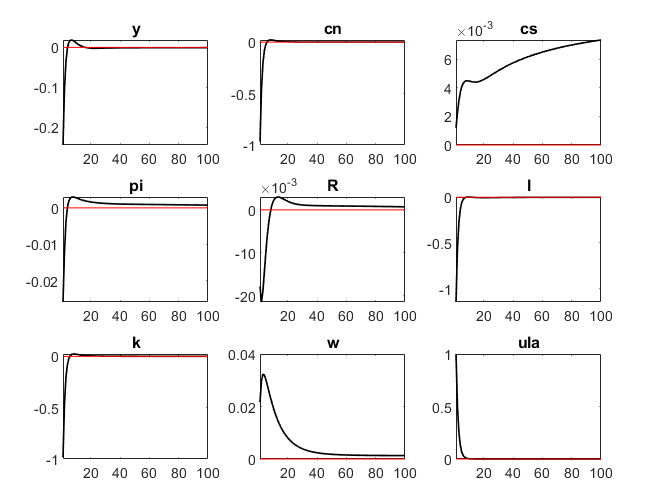Hi,I just added a level productivity shock to Leeper’s,where variables are detrended using Xt.But the irf looked very similar to that of a trend shock.Is it logical?Does a shock to productivity all look so counter-intuitive when variables are detrended?
It still don’t get what you are doing. Say a TFP trend shock increases GDP by 2% in the long run, but it takes two periods to get there. In the first period, GDP only increases by 1%. Because the trend at time 1 jumped up by 2%, you will see a fall of GDP by roughly 1 percent relative to the (new) steady state.
I agree with you at this but does dynare still plot irf by expanding at the steady state level that is the steady-state block?Does steady state still stay at the same level although some say the trend shock is permanent?Plus,at Leeper‘ model ,I added a level shock whose effect should not be confounded by the trend as there is no trend change,the graph is very similar to that of a trend shock.It is strange.
Thanks.I will check the appendix again.
- For the first part, I don’t understand your question.
- A temporary TFP shock should usually increase output. If that is not the case, there is usually something wrong.
To add a level productivity shock,I added a stochastic variable to the production function and marginal cost as follows.
y - ((yss+Omegss)/yss)alphk -((yss+Omegss)/yss)*(1-alph)l-ula=0;
mc-alphrk + (alph-1)w+ula=0;
the evolution of the level productivity shock ula = 0.5ula(-1) + eula;
I keep other functions and parameters as in Leeper’s.It should work if the original codes are correct.But when the irf is plot ,it looks quite similar to that of a trend shock.Could it be due to detrending using Xt or price rigidity?
You should for example check whether that is the correct linearization and where the shock also has to appear.
Thank you for your suggestion.It may be due to price and wage rigidity since I find some similar pattern in other models with wage and price rigidity.